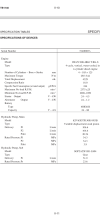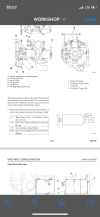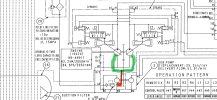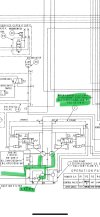Hello!
So I have a weak right track on my excavator. I have been doing some testing around this and narrowed down the problem to the pump. When switching the pump outputs the problem goes to the left, as well the boom gets weak and bucket, which makes sense according to this picture of pumps function from the diagram.
I wonder what the case drain spec is of this pump, because there isn’t one in the manual. I have been doing the calculation of 5% of pumps flow as according from the web. If I take the spec of pump flow from the manual or calculate it from the displacement by RPM I get the results of 10.66-14.96 litres per minute. So I would assume that about 13 litres per minute would be about it I believe.
Well anyways measuring the case drain I got 13 litres in half a minute, I then stopped the machine because the oil in sightglass dropped to the lowest point. This would mean my case drain is 26 litres a minute which would indicate some serious internal leakage.
My question is if my calculation would be correct. If it is I guess the pump is in time of immediate rebuild?
I just want to be sure if this test is reliable for analyzing the pump issues, because searching this forum I saw some information that the regulators can also be at fault. And high case drain can also be caused by some flushing valves? I am not sure if my pump has that.


So I have a weak right track on my excavator. I have been doing some testing around this and narrowed down the problem to the pump. When switching the pump outputs the problem goes to the left, as well the boom gets weak and bucket, which makes sense according to this picture of pumps function from the diagram.
I wonder what the case drain spec is of this pump, because there isn’t one in the manual. I have been doing the calculation of 5% of pumps flow as according from the web. If I take the spec of pump flow from the manual or calculate it from the displacement by RPM I get the results of 10.66-14.96 litres per minute. So I would assume that about 13 litres per minute would be about it I believe.
Well anyways measuring the case drain I got 13 litres in half a minute, I then stopped the machine because the oil in sightglass dropped to the lowest point. This would mean my case drain is 26 litres a minute which would indicate some serious internal leakage.
My question is if my calculation would be correct. If it is I guess the pump is in time of immediate rebuild?
I just want to be sure if this test is reliable for analyzing the pump issues, because searching this forum I saw some information that the regulators can also be at fault. And high case drain can also be caused by some flushing valves? I am not sure if my pump has that.




